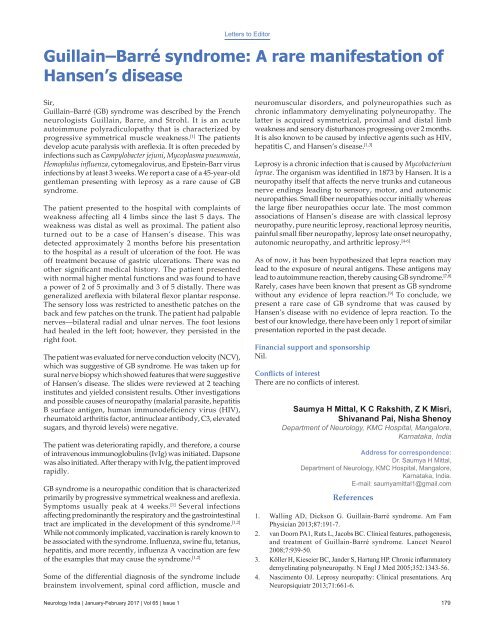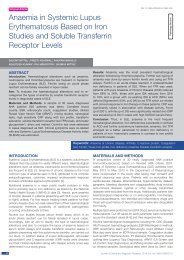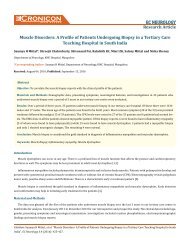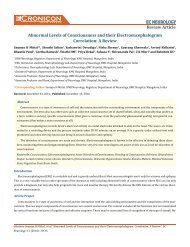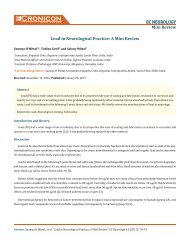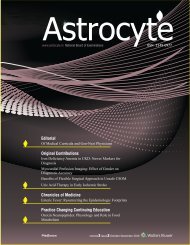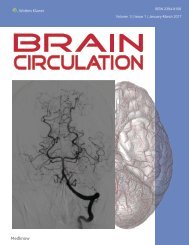Guillain–Barré syndrome A rare manifestation of Hansen’s ds disease
Create successful ePaper yourself
Turn your PDF publications into a flip-book with our unique Google optimized e-Paper software.
Letters to Editor<br />
<strong>Guillain–Barré</strong> <strong>syndrome</strong>: A <strong>rare</strong> <strong>manifestation</strong> <strong>of</strong><br />
<strong>Hansen’s</strong> <strong>disease</strong><br />
Sir,<br />
<strong>Guillain–Barré</strong> (GB) <strong>syndrome</strong> was described by the French<br />
neurologists Guillain, Barre, and Strohl. It is an acute<br />
autoimmune polyradiculopathy that is characterized by<br />
progressive symmetrical muscle weakness. [1] The patients<br />
develop acute paralysis with areflexia. It is <strong>of</strong>ten preceded by<br />
infections such as Campylobacter jejuni, Mycoplasma pneumonia,<br />
Hemophilus influenza, cytomegalovirus, and Epstein‐Barr virus<br />
infections by at least 3 weeks. We report a case <strong>of</strong> a 45‐year‐old<br />
gentleman presenting with leprosy as a <strong>rare</strong> cause <strong>of</strong> GB<br />
<strong>syndrome</strong>.<br />
The patient presented to the hospital with complaints <strong>of</strong><br />
weakness affecting all 4 limbs since the last 5 days. The<br />
weakness was distal as well as proximal. The patient also<br />
turned out to be a case <strong>of</strong> <strong>Hansen’s</strong> <strong>disease</strong>. This was<br />
detected approximately 2 months before his presentation<br />
to the hospital as a result <strong>of</strong> ulceration <strong>of</strong> the foot. He was<br />
<strong>of</strong>f treatment because <strong>of</strong> gastric ulcerations. There was no<br />
other significant medical history. The patient presented<br />
with normal higher mental functions and was found to have<br />
a power <strong>of</strong> 2 <strong>of</strong> 5 proximally and 3 <strong>of</strong> 5 distally. There was<br />
generalized areflexia with bilateral flexor plantar response.<br />
The sensory loss was restricted to anesthetic patches on the<br />
back and few patches on the trunk. The patient had palpable<br />
nerves—bilateral radial and ulnar nerves. The foot lesions<br />
had healed in the left foot; however, they persisted in the<br />
right foot.<br />
The patient was evaluated for nerve conduction velocity (NCV),<br />
which was suggestive <strong>of</strong> GB <strong>syndrome</strong>. He was taken up for<br />
sural nerve biopsy which showed features that were suggestive<br />
<strong>of</strong> <strong>Hansen’s</strong> <strong>disease</strong>. The slides were reviewed at 2 teaching<br />
institutes and yielded consistent results. Other investigations<br />
and possible causes <strong>of</strong> neuropathy (malarial parasite, hepatitis<br />
B surface antigen, human immunodeficiency virus (HIV),<br />
rheumatoid arthritis factor, antinuclear antibody, C3, elevated<br />
sugars, and thyroid levels) were negative.<br />
The patient was deteriorating rapidly, and therefore, a course<br />
<strong>of</strong> intravenous immunoglobulins (IvIg) was initiated. Dapsone<br />
was also initiated. After therapy with IvIg, the patient improved<br />
rapidly.<br />
GB <strong>syndrome</strong> is a neuropathic condition that is characterized<br />
primarily by progressive symmetrical weakness and areflexia.<br />
Symptoms usually peak at 4 weeks. [1] Several infections<br />
affecting predominantly the respiratory and the gastrointestinal<br />
tract are implicated in the development <strong>of</strong> this <strong>syndrome</strong>. [1,2]<br />
While not commonly implicated, vaccination is <strong>rare</strong>ly known to<br />
be associated with the <strong>syndrome</strong>. Influenza, swine flu, tetanus,<br />
hepatitis, and more recently, influenza A vaccination are few<br />
<strong>of</strong> the examples that may cause the <strong>syndrome</strong>. [1,2]<br />
Some <strong>of</strong> the differential diagnosis <strong>of</strong> the <strong>syndrome</strong> include<br />
brainstem involvement, spinal cord affliction, muscle and<br />
neuromuscular disorders, and polyneuropathies such as<br />
chronic inflammatory demyelinating polyneuropathy. The<br />
latter is acquired symmetrical, proximal and distal limb<br />
weakness and sensory disturbances progressing over 2 months.<br />
It is also known to be caused by infective agents such as HIV,<br />
hepatitis C, and <strong>Hansen’s</strong> <strong>disease</strong>. [1,3]<br />
Leprosy is a chronic infection that is caused by Mycobacterium<br />
leprae. The organism was identified in 1873 by Hansen. It is a<br />
neuropathy itself that affects the nerve trunks and cutaneous<br />
nerve endings leading to sensory, motor, and autonomic<br />
neuropathies. Small fiber neuropathies occur initially whereas<br />
the large fiber neuropathies occur late. The most common<br />
associations <strong>of</strong> <strong>Hansen’s</strong> <strong>disease</strong> are with classical leprosy<br />
neuropathy, pure neuritic leprosy, reactional leprosy neuritis,<br />
painful small fiber neuropathy, leprosy late onset neuropathy,<br />
autonomic neuropathy, and arthritic leprosy. [4‐6]<br />
As <strong>of</strong> now, it has been hypothesized that lepra reaction may<br />
lead to the exposure <strong>of</strong> neural antigens. These antigens may<br />
lead to autoimmune reaction, thereby causing GB <strong>syndrome</strong>. [7,8]<br />
Rarely, cases have been known that present as GB <strong>syndrome</strong><br />
without any evidence <strong>of</strong> lepra reaction. [9] To conclude, we<br />
present a <strong>rare</strong> case <strong>of</strong> GB <strong>syndrome</strong> that was caused by<br />
<strong>Hansen’s</strong> <strong>disease</strong> with no evidence <strong>of</strong> lepra reaction. To the<br />
best <strong>of</strong> our knowledge, there have been only 1 report <strong>of</strong> similar<br />
presentation reported in the past decade.<br />
Financial support and sponsorship<br />
Nil.<br />
Conflicts <strong>of</strong> interest<br />
There are no conflicts <strong>of</strong> interest.<br />
Saumya H Mittal, K C Rakshith, Z K Misri,<br />
Shivanand Pai, Nisha Shenoy<br />
Department <strong>of</strong> Neurology, KMC Hospital, Mangalore,<br />
Karnataka, India<br />
Address for correspondence:<br />
Dr. Saumya H Mittal,<br />
Department <strong>of</strong> Neurology, KMC Hospital, Mangalore,<br />
Karnataka, India.<br />
E‐mail: saumyamittal1@gmail.com<br />
References<br />
1. Walling AD, Dickson G. Guillain‐Barré <strong>syndrome</strong>. Am Fam<br />
Physician 2013;87:191‐7.<br />
2. van Doorn PA1, Ruts L, Jacobs BC. Clinical features, pathogenesis,<br />
and treatment <strong>of</strong> Guillain‐Barré <strong>syndrome</strong>. Lancet Neurol<br />
2008;7:939‐50.<br />
3. Köller H, Kieseier BC, Jander S, Hartung HP. Chronic inflammatory<br />
demyelinating polyneuropathy. N Engl J Med 2005;352:1343‐56.<br />
4. Nascimento OJ. Leprosy neuropathy: Clinical presentations. Arq<br />
Neuropsiquiatr 2013;71:661‐6.<br />
Neurology India | January-February 2017 | Vol 65 | Issue 1 179


